2001 Rolex 24 Hours at Daytona...


Tropic Zone Racing Finished The Rolex 24 Running!
Crew Chief: Kevin Petersen. Crew: Mark Bacher, Jimmy Butler, Ron Butler, Mark Conley, Art, Brian & Judy Corbitt, Wayne Foland, Michael Hooten, Ashley Horn, Chuck & Jackie Kerns, Steve (Moose) Kirchoff, John Metros, Gwen Petersen and Bill Rockholtz.
Reports of the days leading up to the race and the race itself are below. Some of the crew may remember it a little differently, but this is what I recall. It is all a little hazy. Pictures of the race are posted in the Rolex Photo Gallery. We also have some short video clips from the race provided by Robert Dubler.
Swiss Drivers to Join Tropic Zone Racing for The Rolex 24! (January 20, 2001)
The Tropic Zone Racing Team is excited to have Robert Dubler of Waltenschwil, Switzerland and Hans Hauser of Mülligen, Switzerland join Dave Bacher and Tony Puleo as co-drivers for the Rolex 24 Hours at Daytona.
Robert Dubler has been competing for many years in the Swiss Championship Races on tracks like Hockenheim, Dijon, Monza, Varono, Al-Ring and Mugello. Dubler has valuable experience with endurance racing. In the United States, he has competed in Speedvision Cup events at Daytona International Speedway, Sebring and Watkins Glen.
Hans Hauser began his racing career in 1988, always driving in Corvettes. In 1996 and 1997, he raced in the BPR GT Series with a Callaway LM and qualified for the LeMans 24 in 1997. Hauser competed in the 1000km in the French GT Series. His experience at the Hockenheim endurance races will be an asset at the Rolex 24.
The Tropic Zone team is completing its preparation for The Rolex 24 Hours at Daytona. Practice and qualifying begin Thursday, February 1, 2001. Pre-race ceremonies begin Saturday, February 3, 2001 at 12 noon EST (6:00 PM Swiss time.) The race will start at 1:00 PM EST and run throughout the night, ending on Sunday at 1:00 pm EST. Speedvision will have coverage of all 24 hours of the race.
Wednesday - Tropic Zone Racing Clears Tech! (January 31, 2001)
Ashley Horn, with the motorhome, was the first team member to gain access to the track around 9:30 am. That worked out well, as it gave the crew a home base to gather out of the rain and plan our next move. Mark Conley and Brian Corbitt picked up one of our golf carts and spent the day running errands and carting parts and people about. Bill Rockholtz brought the U-Haul trailer with the spare parts. It took a while to get it into the paddock area and then later, everything had to be moved to the car trailer for easy access in a hurry.
Dave arrived in the paddock with the trailer with the race car around 11:30 am and the rush to unload and get the car to technical inspection began. Art and Judy Corbitt brought the team radios to keep us in communication between our garage, the motorhome and the trailer.
During all of this action, our Swiss drivers, Robert Dubler and Hans Hauser arrived with several of their support people. I'm sure I will forget someone, but I remember meeting Chris Schober, Rene Tanner, Peter Döbeli and (maybe?) Robert Schück. At this point the whole day is kind of a blur.
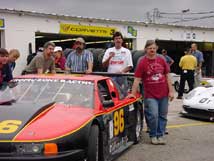
It was about 2:30 before we got the car in line for tech. Crew members Michael Hooten, Ron Butler, John Metros, and Wayne Foland joined in the preparations to get us to tech. We were #11 in line at that time and the line was growing. Already, many cars had been through the process before us. Tech was broken into segments. First the overall bodywork, decals, car numbers and such. Then the bodywork came off the car and we were checked for safety equipment like seatbelts, roll bar padding, fire suppression system, and window nets.
Next, the inspectors moved on to the mechanical items including brakes, suspension, and the fuel system. The engine compression and displacement were checked, along with the carburetor spacing and bore. It was really an event, with crew taking parts off and putting parts on, while the inspectors circled the car continuously.
We were the last car out of tech, but we passed. It was a rush to get the car back to the garage and buttoned down for the night. Everyone was kicked out of the garage area at 5:00 pm. We met again at the motorhome and made plans for Thursday.
We will meet again at 7:30 am when the track opens. Drivers have a meeting at 9:00 am and we have several things to do on the car before our first 1 hour practice at 10:00 am. Our pit is #9 which is very close to "Pit Out", where the cars re-enter the track after pit stops. All of our pit equipment needs to be carted over there. The 2nd practice is from 1:20-2:00 pm and then our 15 minute qualifying session is at 3:25 pm. At 6:00 there is a 2 hour night practice. All of the practices include all the cars at the same time so even they should be interesting.
We are still suppose to have some rain tomorrow, but I hope the weatherman is wrong this time. Once we get rid of the rain it is suppose to get cold. Daytona is not being kind. But...we have cleared a big hurdle today. Tomorrow is another challenge.
Thursday - Practice and 1st Qualifying Session (February 1, 2001)
Thursday morning began with the team making preparations for the morning practice. All Rolex teams shared the same practice time, which began at 10:00 am for an hour. Of course it was raining off and on. Dave Bacher took the car out first to make sure everything was working properly. This was the first time on track after being completely rebuilt for the race. Many changes had been made to the car including a different motor, rear end, and the addition of the rear wing.
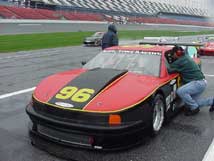
Dave deemed the car in good shape and both Robert Dubler and Hans Hauser took a turn behind the wheel. Everything was looking great. Our tire temperatures were looking good and the car was handling as well as could be expected in the wet conditions. This was the first time either Robert or Hans had driven this car. Both seemed to adapt well to our setup.
The team took a lunch break and fueled the car for the afternoon practice session. Tony Puleo took his first drive in the Olds. It was wonderful to have such a great crew working with us. I was able to test the data feed to our laptop for lap times. I had a receiver hooked up to my laptop and each time a car crossed the start/finish line their lap time would show on my screen. This program provided lap times for all the cars, not just our Olds. Judy Corbitt backed up the system by taking lap times for our car on a stopwatch.
Our qualifying session in the afternoon was declared a 'wet' qualifying, which meant that all the Rolex cars would go on track at the same time for a full 45 minutes. During a 'dry' qualifying, there would be 3 separate 15-minute sessions broken down by the class of car. By putting all the cars out on the wet track at the same time, the track should dry out more. Tony started the session and returned to the pits with a broken transmission. His best lap time of 2:11 would not be fast enough to get us into the race. We would need to do better in Friday's qualifying session.
The crew worked to get our 2nd transmission in the car for the 6:00 pm 2-hour night practice. They did an excellent job. I ran out to get pizza, stopping at the tunnel entrance on my way back to drop a couple of pieces off with the security guards. They really appreciated it and you never know.....
We ate pizza while the drivers took turns in the car. The rain continued off and on as it had all day. It was determined that we still had a problem with the new transmission and we called the practice session over. The car was taken back to the garage, but there was not time enough to complete repairs before the garages were closed for the night. Everyone agreed to be back at the garage when it opened at 7:30 am on Friday to see what could be done. It was a long day and we had another long one ahead of us. We had to get the car ready to qualify.
Friday - Practice and 2nd Qualifying Session (February 2, 2001)
Friday morning was just as wet as the last few days in Daytona. All of our crew faithfully showed up at 7:30 am when the garages opened. They went about pulling the transmission back out of the car to see if it could be fixed. It was determined that the throwout bearing needed to be replaced. Our only practice session of the day was scheduled for 11:15 am and only for 45 minutes. Wayne Foland, Michael Hooten, Mark Bacher and the crew worked diligently to get the trans fixed and back in the car. The practice session started with the crew rushing to get the car back together. Dave Bacher patiently sat in the car. Just as the window net was being put into place the checker flag came out on the practice session. Qualifying would have to be the test for the transmission.
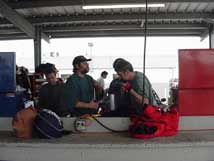
As best as they could, the crew tested the transmission up on jack stands. There was still a noise that made all of them look very unhappy. As the 2nd qualifying session rolled around the clouds began to darken again. We were all hoping for rain so that the session would be declared a 'wet' session. That would keep other qualifying times lower and give us a better chance of making the field. The oil pump for the trans was not sounding good at all. If Dave went out to qualify and the drive train locked up, he would be into the wall for sure. Not a pretty thought.
The gods smiled and the session was declared 'wet', but the rain only drizzled. The crew struggled to make more repairs. With only 15 minutes left in the session, Dave made the decision to go for it. We buckled him in and sent him out with 10 minutes to qualify. I figured we needed a 2:00 to make the field. The track had dried some during the session. I clicked the watch at the entrance to pit road by the 76 sign as Dave rolled out and then I made the mad dash with the golf cart to our pit #9 at the opposite end of the track. We arrived just as Dave was coming past the pit. I clicked the watch. It had taken 2:41 to get down pit lane. I anxiously awaited his next lap. Bingo..1:57! Our crew chief, Kevin Petersen, said. "No way." But I knew. Next lap, right on the money, another 1.57. Dave ran only 5 laps before the checkered flag flew, but we were in!!
Race Day (February 3-4, 2001)
Race day started bright and early at 7:30 am with the crew busy setting up the car with heavier springs and a different rear gear. Chuck and Jackie Kerns joined the team to provide hot food to the crew during the long race. Others on the crew were transporting the equipment to our assigned pit area #9. The Broadfoot Racing Porsche was our assigned 'pit mate'. It was not long before 11:00 am rolled around and the car was due at pre-race grid.
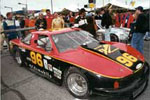
As the team rolled the car toward the staging area, it became apparent that this was going to take a while. The congestion of cars, drivers and team members grew and everyone waited patiently for the Grand Am officials to signal our turn. The excitement grew as we took our position on the grid. The photographers made their rounds taking pictures of teams and their cars and we buckled Dave Bacher into the car. The announcer began introducing the starting line up and then came the famous "Gentlemen and Ladies, start your engines." The grid was ordered cleared and everyone rushed to take their position in the pits for the start of the race.
The start of the race was an anxious moment as the cars entered Turn 1. The track was damp but not wet enough for rain tires. The cars sorted themselves out on track and we settled into race mode to wait for our first pit stop. About ½ hour into the race a full course yellow (FCY) flag was displayed. Dave brought the car in to check everything over and turned the wheel over to Tony Puleo. The crew quickly discovered that the fueling hose did not seal properly when attached to the car and we were dumping fuel on pit road.
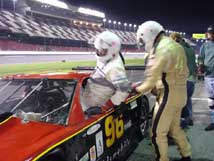
An hour later Hans Hauser took his first stint in the car. We were still dumping gas as we refueled. The fire marshall was not impressed and we were told one more stop like that and we couldn't fuel the car anymore. Hans took the car into 3rd Place in the AGT class behind the 18 car and the 44 car. Luckily our crew managed to fix the fueling problem before our next stop.
At 3:30 pm Hans turned the car over to Robert Dubler. Somewhere around 4:00 pm Robert took the lead in the AGT class. We had our moment of quiet celebration. The rain started again and Robert brought the car in for rain tires and Dave Bacher got back in his car. The team spent the next couple of hours changing from rain tires, to slicks, and back to rains. Tony Puleo took another turn in the car before Hans Hauser took another drive. Then at 7:09 pm it happened.
We could see it on the television in our pit. Hans was on the short straight headed toward the International Horseshoe when the back end of the car broke loose and he went off course, through the grass and impacted the tire wall with the left front of the car. It was a fairly hard hit and the car turned its right side into the tires also. This was not something Hans was going to drive away from. The crew rushed to meet the car at the garage.
The crew worked to replace the front nose box, straighten the bolt in the steering rack and re-align the car the best they could. We did not have an extra hood. I stayed in the pit area straighten tools and cleaning up paper plates and cups. At 8:40 pm Tony Puleo rolled back onto the track minus the hood.
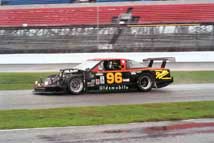
We settled back into race mode and at our 10:00 pm scheduled pit stop, Robert got back into the car. Everything seemed to be working smoothly as the crew went about their various tasks. Then around 10:30 pm the fuel bladder sprung a leak.
For those of you not familiar with racing, the fuel bladder sits on top of an aluminum platform about six feet off the ground. It is a strong rubber compound of some sort, that holds around 55 gallons of gas, but is not contained inside any aluminum structure. Gravity feeds the fuel through long hoses to the car.
Kevin Petersen, our Crew Chief, was the first one to smell the gas. The crew sprang into action to contain the leak and don the protective belaclavas (head coverings) and goggles. The best solution seemed to be to bring the car in and put the fuel in the car. Our scheduled fuel stop was only 6 laps away.
Our problems were compounded when we discovered that Kevin's radio battery had gone dead. This was the only radio we had to communicate with the car. Although I knew that Robert would bring the car in when the fuel ran low and he switched to reserve, I was worried that we would have no way to refuel with all our gas leaking on the pit floor.
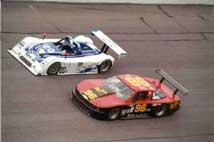
While we struggled to change the battery in his radio, Kevin ran to the pit marshall to have the car black flagged. The black flag requires that the driver to come into the pits. We needed to get that fuel in the car. As Robert acknowledged the black flag and was preparing to bring the car in, we restored radio contact with him. The car rolled to a stop in the pit stall and the crew was ready to refuel.
At first, the pit marshall wouldn't allow the crew to refuel with the leaking bladder. Then common sense prevailed and we were given the go ahead. Robert was off and running again and the crew went about cleaning up and recovering from the scramble.
The old saying goes "One person's misfortune is someone else's fortune." The Broadfoot Racing Porsche, who was pitted with us, had dropped out of the race a short time earlier. They sportingly agreed to let us use their fueling rig for the rest of the race and our team set about moving the rig so it would reach our car. Another catastrophe aborted. Robert ran a double stint as the crew, once again, regrouped.
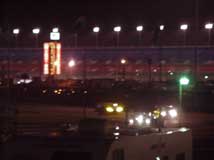
At midnight, when Hans got in the car we were running in 4th spot in the AGT class. Just before 2:00 am Tony Puleo climbed into the car. He only ran a few laps before the transmission broke and the Olds went to the garage. The crew, with Wayne Foland, in the lead, spent the next 5 hours building a new transmission from the remains of two broken ones. Everything looked rather bleak. Could it really be done?
Yes! At 7:12 am the car, with Tony at the wheel, once again rolled down pit road toward the track. The Olds took two more short trips to the garage to try to weld a leaky header. Tony continued running with the car 'popping' as he down-shifted. At 9:30 am Robert Dubler got in the car when we changed from rains back to slicks once again...and then at 10:00 am back to rains. Hans turned down another stint in the car and Robert drove until 11:15 am when Dave Bacher climbed back into the car to try and nurse it to the Finish.
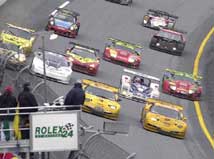
Robert told us that the clutch was slipping badly, which slowed the car. The time left until the checkered flag seemed like an eternity. Dave brought the car in for it's last pit stop and all that was left to do was watch and hope.
At 1:00 pm Dave brought the car into position in the blockade of cars forming behind the leading Corvette and took the checkered flag. Finishing 4th in class and 48th overall, we had run 407 laps and most of all had survived!
All the teams swarmed pit road as the cars rolled in. It was a jubilee of high fives, crew, drivers and photographers. For a few fleeting moments everyone basked in the glory and wonderment of it all.
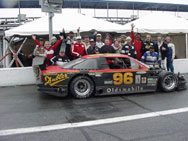
Then it was back to business as the weary crew packed up the pit equipment and loaded the car back into the trailer for the trip home. Of course it continued to rain for this also. Too soon, Daytona International Speedway fell silent and was deserted again.
Our crew was a hodge-podge of people who volunteered their time and energy. Several had never met before this race. They melded into an efficient crew who pulled together to keep the car running. My heartfelt thanks goes out to each of them. They have given us an experience we will never forget.

